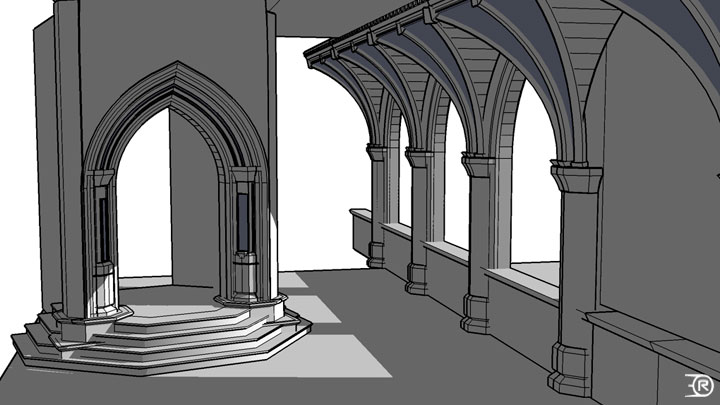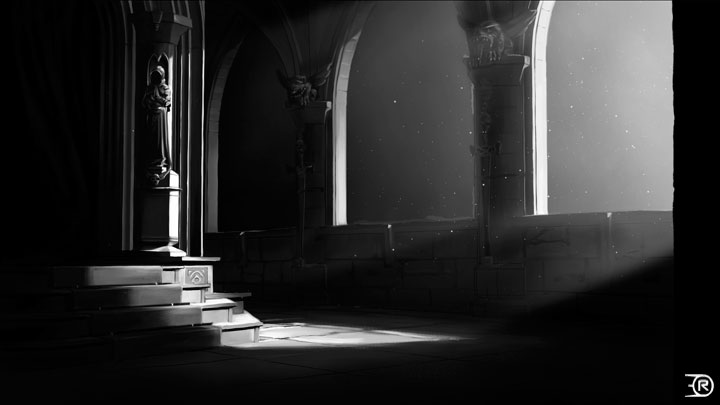Alex Jenyon – SketchUp in production
SketchUp in production – Interview with Alex Jenyon
Can you tell us a bit about the kind of work you do?
I’m a freelance matte painter and concept artist in the visual effects industry in London. I’m hired to design and produce concept paintings and matte painted backgrounds for commercials, TV shows, Feature films and… other random internet-based stuff. All kinds of things, really.
What are some of the big projects you’ve worked on recently ?
I did a lot of design work and matte paintings for the, erm, ‘amusingly’ titled comedy/horror film ‘Lesbian Vampire Killers’. It came out in the UK in March – no idea if the rest of the world has had the pleasure yet. It’s not a particularly high-profile film, but it was a LOT of fun to work on. I’ve also worked on Guy Ritchie’s ‘RocknRolla’, ‘Human Body: Pushing the Limits’ for Discovery, Nick Moran’s new film ‘Telstar’ and the Hollywood film ‘Stardust’. Lots of commercials, too – UEFA Champion’s League, Hyundai, Toyota, Co-op, Ribena… Right at the moment, though, I’m doing some designs for the re-imagined ‘The Day of the Triffids’.
How did you get in to doing this kind of work?
I studied Theatre Design at Central Saint Martins in London. It was a good course in terms of developing design skills, but rubbish at teaching technical ability. So during my summer breaks, I got a job at Sony Computer Entertainment as an ‘assistant computer game designer’ – a LOT less glamorous than it sounds. But it did mean that they taught me the 3D application ‘Maya’, so by the time I graduated I had experience of both the (rather pretentious) world of theatre design, as well as the ‘down and dirty’ world of a studio game production. Slightly weird mix, but it’s helped me ever since…
A while after graduating, I managed to get a job helping out in the art department of a small stop-motion animation company in Bristol. They were just starting work on a feature version of ‘The Fabulous Furry Freak Brothers’, and I was hired to to ‘do a bit of photoshop’. I ended up staying for 8 months, and helping design a lot of the sets the film would need. Sounds great so far, doesn’t it? Unfortunately, they didn’t get the funding they wanted to finish the film, I ended up working behind a bar, and because the designs I had done were under non-disclosure I couldn’t show them to anyone to get a new job! I therefore spend a lot of time (this was 2005) working on my portfolio, and it picking up bits of freelance work where I could.
Early 2006, though, I got a call out of the blue from ‘The Mill’ in London. They do visual effects solely for commercials, and they hired me as a texture artist on a short-term contract, which again turned into quite a few months of work. A while after I started working there, they got in a commercial that needed a football stadium as a background, and the producer gave the job to me. I therefore went back to my desk, and made the background they wanted using a combination of 3D models, painted 3D cards and projected textures. I was congratulated on producing a ‘good matte painting’.
Up until that point, I’d never really considered that what I had been doing actually WAS a matte painting, or that this was what I wanted to do with my career. But after being unwittingly paid to produce my first one, I’ve been doing them ever since. It’s a great combination of creativity, technical ability, problem solving and storytelling that I really enjoy, so I’m really grateful it sort of landed in my lap…
Late in 2005, I got a contract with an online games company to do some set designs for a virtual casino. I promised I’d turn up the next week with my ‘own kit’, and start work. Problem was I didn’t own a laptop at the time, and certainly didn’t have the money for a copy of Maya to run on it. So I had about a week to buy a laptop, find a 3d modeling package I could afford, and then…. um, learn it…
Can you give us some idea of your workflow? How does SketchUp fit in to your day-to-day work?
I use SketchUP extensively all of my design and planning work. It’s very rare that I use it to produce finished renders or models, but it’s a crucial ‘first step’ in my design process. I use it to make rough set visualisations, choose camera angles, and lay out the perspective required for further painting. Probably easiest to explain with an example:
Because I found myself working in studios without access to either a printer or a scanner, I was forced to make a big shift in my painting style – instead of producing meticulously neat line drawings on paper, I started simply painting over the SketchUP renders digitally. My use of pencil and paper has been declining ever since (I don’t think I’ve touched a pencil for about 8 months now).
Every few months, I decide that I’m using SketchUP as a kind of ‘crutch’, and that I’m going to do a painting ‘from scratch’, without using any 3D at all. I then spend a frustrating amount of time constructing perspective grids by hand, working out vanishing points and drawing endless thumbnails – and the result is always slightly inferior. With a sketch model constructed in 3D, I know that the scene I’m painting is physically possible, that the perspective is correct, and that I’m happy I’ve chosen the best composition. I can then concentrate on the more creative aspects of the painting – the atmosphere, lighting, form, texture, details – knowing that the basics of the painting are sound.
What are your favourite features of SketchUp?
My number one ‘feature’ of SketchUP is not really a feature at all, but the actual modelling / inference system itself. Because I sit half-way between 2D and 3D, I love the fact that SketchUP is a 3D package in which you actually draw lines to construct your models, rather than having to worry about polygons, vertices and control points. In terms of actual features, I’ve found ‘styles’ and ‘photomatch’ to be incredibly useful. Google’s 3D warehouse has also been a great help (you can see why I was so pleased with SU6!). When I have only a few minutes to construct a set, 3D warehouse in invaluable. It’s particularly useful for storyboarding – if the script specifies ‘helicopter’, it doesn’t really matter what KIND of helicopter at the storyboarding stage. It’s obviously going to matter later on, but at the storyboarding stage all the matters is that there is a helicopter in the scene – and I can probably find one in only a few minutes on 3DW.
Do you use any companion software with SketchUp – i.e. a rendering or animation solution?
I’ve recently purchased ‘Vue’ to help with my matte painting work. It is still a little bit flakey as an application, but it deals with SketchUP geometry really well. An SU model tends to have all kinds of smoothing and normals issues when importing into Maya, but Vue never seems to have any problems. I’ve therefore been able to use SketchUP as the first stage of some of my matte paintings, as well as my concept design work.
Here is an example of starting with a rough SketchUP model, matching it to a real-world plate, and then producing a photo-real matte painting:
One of Vue’s big selling points is the ‘ecosystem’ feature, which lets you ‘grow’ landscapes containing hundreds of thousands of realistic plants. However, you can put ANYTHING into these ecosystems – including SketchUP geometry. This lets you ‘grow’ entire cities from scratch, or produce crowds of people to fill a stadium. As I don’t have any work I can show you (damn NDA’s again), here’s a very quick example of ‘growing’ a shanty town on the side of a hill. Total time to produce this image (inc. 10 min render): 30mins. It could certainly do with some post work, but it’s a good demonstration of the ease with which very complicated scenes can be produced.
What Ruby scripts do you rely on?
I never really find myself using many ruby scripts – not really sure why. I’ve got all the really significant ones installed/purchased (FFD, ToS, SoapSkin, SDS etc.) I’ve used each of them once or twice when I had a modelling problem that I couldn’t solve any other way, but most of the time I find the standard tools sufficient for the ‘quick and dirty’ models I normally produce. Since my work is all about speed, I don’t really get much time to experiment while I’m on a job – so learning more of the capabilities of these scripts is something I need to work on in my own time.
I have found a lot of use for a nice little script from Mr. Marshall (camera2modo), that exports SU camera to… Modo (unsurprisingly). I’ve been using it as the first stage in an unnecessarily complex workflow to get the camera data, eventually, into Vue. I’ve been re-writing the script as a ‘one click’ export from SU to Vue, which has been taxing my brain (unused to coding) to the limit. I’ve got even more respect for the Ruby guys now! When (if) I get it to work without all the heinous hacks I’m currently employing, I’ll post it out the the community.
How would you like to see SketchUp develop?
I’m still using SU6, as I couldn’t see anything in SU7 that would help me in my work. For Architects and Product designers, I’m sure dynamic components are a brilliant new tool, but they aren’t particularly useful to me at all. Along with the rest of the SU community, I’d obviously like to see the mundane things fixed first – the notorious shadow bug (that’s tripped me up in front of clients), better performance with high polycounts, more import / export formats… all the boring stuff.
In terms of a wish list, I’d LOVE to get openGL support for more than one light source. I often use SU to work out what’s going to be in shadow in a particular scene, and the single light source rather limits this to outdoor sets only. Native directional, point and spotlights would be brilliant.
And you’ve got a new tutorial for us?
I posted a tutorial on one of my background paintings for ‘Lesbian Vampire Killers’ last month, which seemed to go down really well. It’s been translated into French (thanks to Frenchy Pilou), posted on a Brazillian SU usergroup, and hit my server with nearly 7GB of bandwidth…
Here’s another from the same series – ‘part 2’ if you like:
Where can we see more?
I’ve got a lot more work on my website, which I try to keep updated as often as possible. There’s a showreel there too, so you can see some of my paintings ‘in motion’. www.aj-concepts.net
Oh, and before I finish, here’s a little experiment of mine – using Justin Chin’s SketchUp character rigging hack for a piece of character design:
Thanks for spending time with us and sharing your ideas and thoughts…
No Problem, my pleasure!
Alex Jenyon























